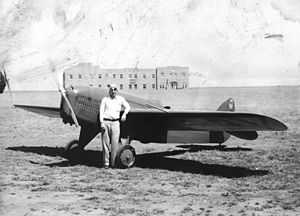Cessna GC-1
| Cessna GC-1 | |
|---|---|
 | |
| Role | Air racer |
| National origin | United States of America |
| Manufacturer | Clyde V. Cessna Aircraft Company |
| Retired | 1932 [1] |
| Number built | 1 |
|
| |
The Cessna GC-1 was an air racer built to compete in the Cirrus All American Air Derby in 1930.
Design and development
Cessna built the GC-1 for Blackwell Aviation to compete for a $25,000 prize in the 1930 Cirrus All American Air Derby. Blackwell registered the Cessna GC-1 NR-144V.[2]
The aircraft was a mid-wing open cockpit taildragger. The landing gear was attached by struts to both the fuselage, and the wing spar.[3]
A more powerful version with a shortened fuselage was built as the GC-2, powered by a 110 hp (82 kW) Warner Scarab 7-cylinder radial engine.
Operational history
Stanley Stanton placed seventh in the 1930 Cirrus All American Air Derby with the GC-1. The press proclaimed the racer the "Winged Torpedo".[4] E.B Smith flew the aircraft in the 1930 National Air Races placing fourth with an average speed of 137.4 mph.
The GC-1 was destroyed in a landing accident, in collision with a mail plane at Kansas City airport.
Variants
- GC-1
- The sole GC-1, given the name Miss Blackwell, was completed in 1929, powered by a 95 hp (71 kW) Cirrus Ensign.[5]
- GC-2
- A second aircraft almost identical to the GC-1, but powered by a 110 hp (82 kW) Warner Scarab and fuselage length of 20 ft 5 in (6.22 m).[5]
Specifications (Cessna GC-1)
Data from Sport Aviation[2][5]
See also
- Related development
References
| Wikimedia Commons has media related to Cessna GC-1. |
- ↑ "Cessna CR-1". Retrieved 27 April 2011.
- ↑ 2.0 2.1 "The Cessna CR-1 and CR-2 Racers". Sport Aviation. April 1958.
- ↑ "Clyde Cessna's budget racer". Retrieved 27 April 2011.
- ↑ Sylvester H. Schmid, Truman C. Weaver, EAA Aviation Foundation. The Golden Age of Air Racing: 1927-1933.
- ↑ 5.0 5.1 5.2 Eckland, K.O. "Cessna". aerofiles.com. Retrieved 17 September 2014.
| ||||||||||||||||||||||||||||||||
| ||||||||||||||||||||||